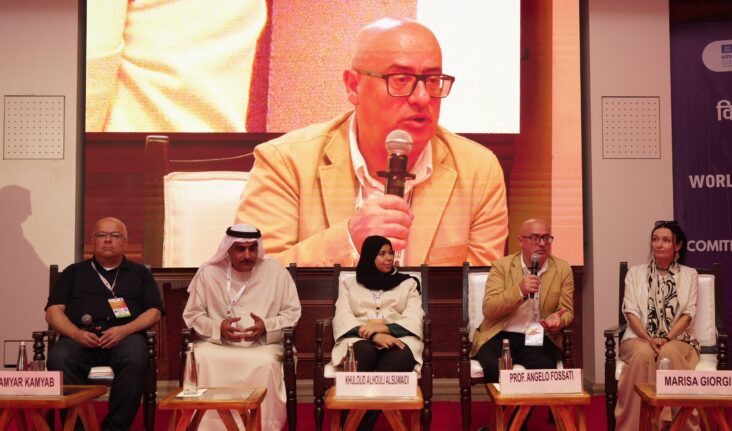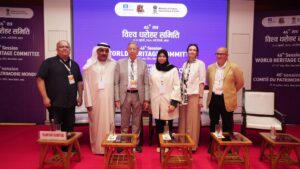Sharjah Archaeology Authority Showcases Innovations In Digital Preservation Of Cultural Heritage At 46th World Heritage Committee Session In India

As part of its ongoing efforts to preserve the rich cultural heritage of the Emirate of Sharjah and raise awareness both locally and globally, the Sharjah Archaeology Authority (SAA) organized a seminar titled “Digital Preservation: Ensuring Cultural Legacy”on Friday, on the sidelines of the 46th session of the World Heritage Committee in New Delhi, India. The seminar was attended by H.E. Eisa Yousif, Director General of the Sharjah Archaeology Authority, Shaikh Ebrahim Bin Humood Al Khalifa, Deputy Director of the Arab Regional Centre for World Heritage, Dr. Jad Tabet,World Heritage Expert, and Khuloud AlhouliAlsuwaidi, Director of the Tangible Cultural Heritage Department at the SAA, along with a group of academics, archaeologists, and researchers.
The importance of digital transformation in documenting cultural heritage
H.E. Eisa Yousif, Director General of the Sharjah Archaeology Authority, said: “The organization of this seminar reflects our deep commitment to preserving the rich cultural heritage of the Emirate of Sharjah, in line with the directives and vision of His Highness Sheikh Dr. Sultan bin Mohammed Al Qasimi, Member of the Supreme Council and Ruler of Sharjah. Within the framework of the SAA’s strategy for the sustainability and preservation of cultural heritage, the use of digital methods is a significant step that allows us to preserve the cultural legacy in its various forms more accurately and sustainably. This enhances the SAA’s objectives of internationally sharing knowledge on harnessing modern technologies in cultural work and using them to document and protect cultural heritage to ensure its preservation and transmission to future generations. We start from our belief that human cultural heritage is a means of communication between cultures and peoples of the world, as it is a shared responsibility requiring everyone’s cooperation, and we are proud to be part of this global effort.”
H.E. Eisa Yousif emphasized that technological advancement is the most prominent factor in developing digital preservation methods in the field of heritage.
This seminar represented a unique platform and opportunity for academics and specialists from the SAA to share their efforts in documenting artifacts and historical cultural landscape with a group of international world heritage experts. The SAA focused, during this seminar moderated by Dr. Mounir Bouchenaki, advisor of Arab Regional Center for World Heritage, on documenting rock art in the Arabian Peninsula and the rich history that spans seven thousand years, as well as historic landscapes, with meticulous scientific accuracy and historical cultural scenes. This serves as a means to create detailed and accurate records of them, ensuring their preservation even with physical changes over time due to environmental changes, natural risks, or human activities.
Showcasing Sharjah Archaeology Authority’s Digital Heritage Documentation Excellence
During the serminar, Khuloud AlhouliAlsuwaidi, Director of the Tangible Cultural Heritage Department at the Sharjah Archaeology Authority (SAA), presented an in-depth overview of the SAA’s pioneering approach to digital cultural heritage documentation. She emphasized the seamless integration of traditional and manual techniques with advanced digital methods, creating a comprehensive 360-degree view of Sharjah’s archaeological treasures. This initiative aims not only to preserve the cultural heritage of Sharjah but also to share it globally.
AlhouliAlsuwaidi highlighted the SAA’s commitment to strategic goals that focus on the preservation and meticulous documentation of cultural heritage. This effort ensures accessibility for the local community, the general public, and academics, while also facilitating the dissemination of related studies. The preservation processes effectively balance cutting-edge digital methodologies, such as 3D technologies and satellite imagery, with traditional manual techniques. This balanced approach is particularly crucial for specific cases, such as the dating of rock inscriptions, where manual techniques have proven to be highly successful.
It is noted that the Authority has documented approximately 500 artifacts using 3D, virtual reality, and augmented reality techniques, in addition to 300 rock inscriptions and 35 three-dimensional archaeological sites. The Authority has also delivered over 100 academic lectures attended by 7,600 participants, and has published 80 works, including annual journals documenting excavation missions, archaeological books, and academic articles.
Combining Traditional Approaches with Digital Technologies in Rock Art DocumentationThe seminar featured a presentation by Marisa Giorgi, one of the leading experts in this field, offering a comprehensive vision on how to use technology to create detailed and accurate digital records that help preserve cultural heritage for future generations. Dr. Angelo Fossati, an expert in rock engravings at the Sacred Heart University in Milan and the President of the International Federation of Rock Art Organizations, discussed the efforts to integrate traditional methods with digital technologies in rock art documentation. He elaborated on how combining these methods ensures the accuracy and sustainability of documentation, forming a valuable database for researchers and experts in the future, as the dating of rock inscriptions is only precisely achieved using traditional techniques in manually documenting the drawings.
Digital Mapping of Historical Cultural Landscapes
On the other hand, Mr. Kamyar Kamyab showcased experiences in digital mapping of historical cultural landscapes, demonstrating how this technology has revolutionized the study and documentation of historical landmarks, acquisition of 3D data, and satellite imagery. He also highlighted the importance of creating digital records that contribute to preserving crucial information about archaeological sites and historical environments.
Virtual Reality and Metaverse Experience through the “Archaeology Center”The seminar featured a display of digital cultural landscapes and the innovative use of virtual reality and the metaverse in the SAA’s “Archaeology Center” project. This groundbreaking initiative aims to offer a realistic simulation of archaeological sites in the Emirate of Sharjah. Using virtual reality, viewers can experience the process of carving rock inscriptions and learn about the tools used, providing an immersive educational experience. It stands as a pioneering project among cultural heritage institutions in the region.
Furthermore, the “Jabal Khatm Al Mleiha Archaeological Trail,” featuring over 120 Neolithic rock inscriptions, allows visitors to explore these ancient carvings through a virtual mountain trail experience. The presentation also included two stone models of rock art from the Emirate of Sharjah, enhancing the interactive experience for visitors.
In February 2023, the Sharjah Archaeology Authority achieved a significant milestone by adding several rock inscription sites in Sharjah to UNESCO’s World Heritage Tentative List. These sites include the rock inscriptions at KhatmMleiha and Khor Fakkan, along with the Wadi Al Helo site, which provides evidence of Bronze Age copper mining on the Arabian Peninsula. Additionally, the “Faya Palaeolandscape” World Heritage Nomination underscores the rich historical significance of the Emirate of Sharjah, highlighting it as one of the most crucial Stone Age sites in the Arabian Peninsula and the world.


